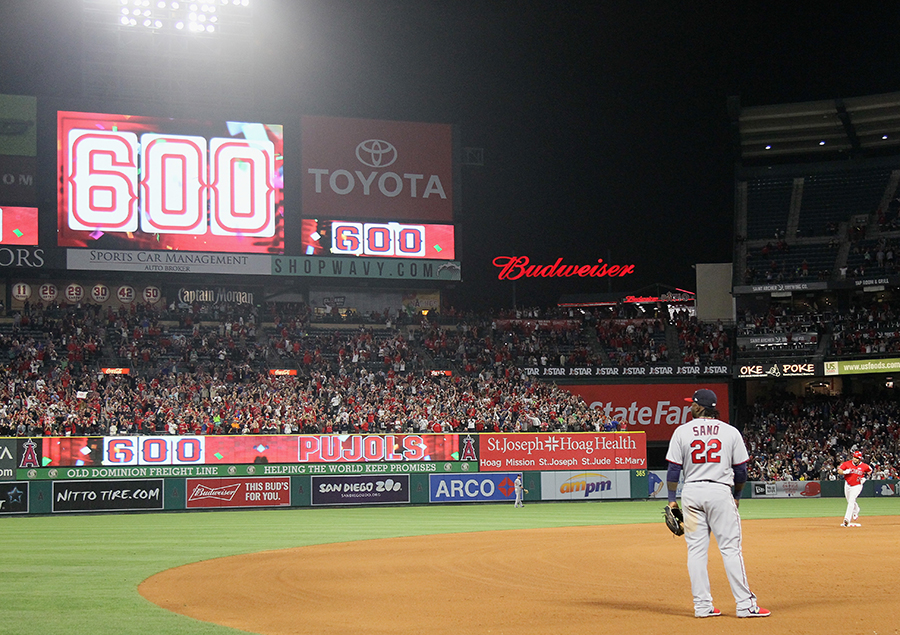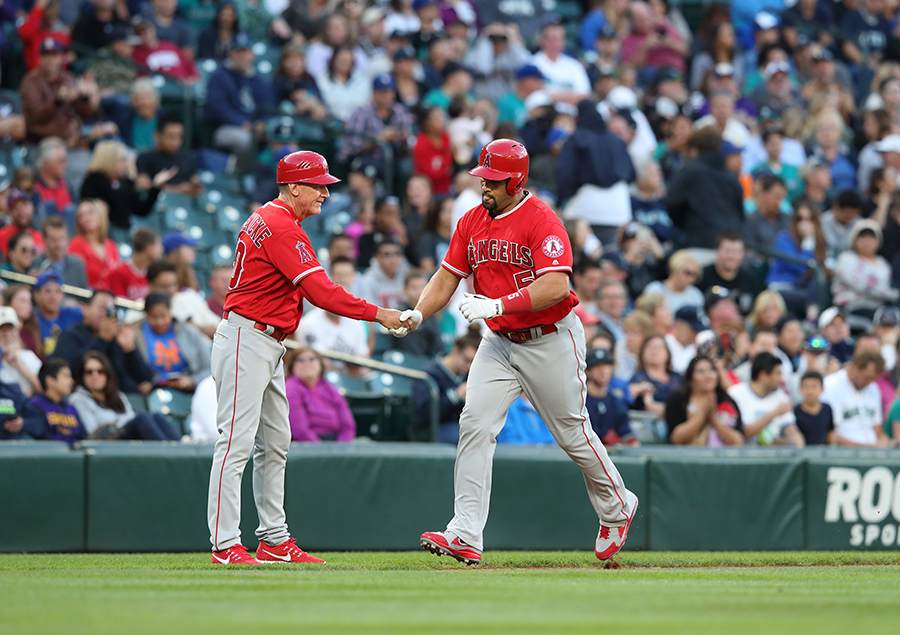Pujols Is Simply The Best


Albert Pujols succeeded all-star first baseman Mark McGwire in St. Louis and then mentored Mike Trout in Anaheim after joining the Angels in 2012. Trout is Pujols’ heir as the best position player in the game. (Matt Brown/Getty Images)
Albert Pujols’ 600th home run came amid barely a shred of national buzz. There were 40,236 fans in attendance at Angel Stadium the night of June 3 when he launched a grand slam off the Twins’ Ervin Santana to reach a milestone attained by just eight other players in major league history.
But the general sense of blasé surrounding the event suggested a big swath of the baseball-viewing public was either ambivalent or asleep. Milestone fatigue and the Pacific Time Zone can be a powerful combination in suppressing interest on a national scale.
Inside the workaday bubble, the teammates and opponents, pitchers, hitters, managers and coaches who’ve watched Pujols perform for the past 17 years know what he brings to the equation. Padres bench coach Mark McGwire, who spent the final year of his career as Pujols’ teammate on the 2001 Cardinals, is on board with the idea that the second first baseman to reach the 600 barrier (after Jim Thome) might well be the greatest ever to play the position.
“Nobody in the history of the game did what Albert did for the first 10 years of his career,’’ McGwire said. “Unfortunately, the injuries have slowed him down. But you’ve got 600 home runs and more to come. (Two) Gold Gloves. I can’t say enough. There’s a reason why they call him ‘The Machine,’ because he was ‘The Machine’—the most feared hitter in this game. If he doesn’t go down as the best (first baseman), he’ll go down as the second best.”
 Albert Pujols (Photo by Stephen Dunn/Getty Images)
Albert Pujols (Photo by Stephen Dunn/Getty Images)
Any comparison of players separated by multiple generations must take into account the habitual tilt toward household names who did their best work before World War II or the advent of television. No one would ever dream of ranking Otto Graham or Johnny Unitas ahead of Tom Brady and Peyton Manning on a list of NFL’s greatest quarterbacks, and Wilt Chamberlain and Oscar Robertson have gradually drifted down the list of NBA greats as Michael Jordan and LeBron James have burnished their credentials. Yet baseball clings to the distant past. Ted Williams will forever be proclaimed the greatest hitter who ever was, and Willie Mays remains the symbol of all-around brilliance in a five-tool package. There’s little to nothing Mike Trout can do on a baseball field to alter that perception.
“It’s driven into your mind that ‘nobody was as fast as Walter Johnson,’ ” said Steve Hirdt of the Elias Sports Bureau. “Oh yeah? There are five guys in the bullpen tonight who are faster than Walter Johnson.
“To me, when you’re asking who was the greatest ever, it only makes sense to compare people to the era in which they played, and try to say how much better than your colleagues and your contemporaries you were. So if you’re standing Albert Pujols next to Lou Gehrig right now, I would think that Pujols is bigger, stronger and can accomplish more on a baseball field. But he has the benefit of greater nutrition, greater medical care and things like that. That’s why the inter-generational comparisons fall apart, if you just do it on a tale-of-the-tape comparison one against the other.”
Gehrig, the Iron Horse, has long been regarded at the gold standard at his position for an abundance of reasons. Among post-1901 players who spent at least 50 percent of their careers at first base, he is all-time career leader in runs (1,888), RBIs (1,995), on-base percentage (.447) and slugging (.632). It’s no wonder Elias’ Hirdt regards him as the “leader in the clubhouse.”
Numerically, Pujols stacks up well in terms of counting stats. Among first basemen/DH players, he trailed only Thome for home runs and David Ortiz for doubles, but he can pass both in 2018, if not this season. Pujols ranks third in hits behind Eddie Murray and Rafael Palmeiro, with more time left to add to his achievements.Pujols also earns special bonus points for a stellar postseason record, which is highlighted by a .323/.431/.599 slash line in 77 playoff and World Series games.
Playing conditions change markedly over a 70-80 year gap, and some obvious distinctions between the two must be taken into account. Gehrig’s peak came when there were just eight teams in the American League, compared to 15 today, so the talent was more condensed. But he also compiled his numbers before Jackie Robinson broke the color barrier, coast-to-coast travel took a toll on players and exhaustive bullpen matchups became the norm. How much should those changes be factored into the equation?
Gehrig is mythologized for his streak of 2,130 consecutive games, and his death at age 37 made him a tragic figure of epic proportions. Pujols is playing this year at age 37 and still has four years left on a 10-year, $240 million contract. That’s an indicator of how times have changed. While Pujols will never attain the iconic status of Gehrig, he is nevertheless revered by teammates and opponents for his consistency and dedication to the game. Based on the anecdotes of his peers, he possesses all the traits commonly prized in superstars and first-ballot Hall of Famers.
Presence
Pujols is such a commanding figure at the plate, opponents regard personal victories over him as respites rather than an opportunity to gloat.
“He’s still scary when he gets into the box,” said Tigers righthander Michael Fulmer. “I remember my first time facing him last year (as a rookie), I made the three best pitches of my whole career. I threw him two four-seam fastballs down and away. He took the first one, swung through the second one, and then I threw him one of the best sliders I’ve ever thrown. I don’t know how—I can’t replicate it. He swung through that one, too, but just kind of seeing him in the box, and obviously I watched him growing up. I was a huge fan of his. Just to be able to pitch to him, it was something I’d never thought I’d dream of.
“I exhaled for sure when I struck him out. I kind of turned around and to myself said, ‘How did I just do that? I can’t believe I just did that.’ It was a surreal moment. His whole career has been unbelievable. For him to get to 600 home runs, I was very happy to see that.”
Durability
Pujols doesn’t have a memorable streak to call his own, but he sure has had a knack for showing up. He appeared in 1,705 of a possible 1,781 games during his 11-year run with St. Louis, and his durability was even more impressive because of the physical challenges he endured over time. Pirates third baseman David Freese, who played with Pujols in both St. Louis and Anaheim, marvels at Pujols’ ability to stay on the field despite a broad-based, physically taxing stance that took a toll on his legs and lower back.
“I can’t imagine being in that stance for 20 years,” Freese said. “That’s insane. He gets so far down there, it’s got to wear on him. In the clubhouse, you see how guys are hurt and have nagging injuries, and he’s dealt with that most of his career. But 160 games later, he’s still in there unless he has surgery. It’s all about having the desire and the focus and the need and the want to be out there. He’s the complete package.”
 Albert Pujols won one National League batting title, two home run titles and three times led in OPS. His average has dipped to .263 with Anaheim, though he continues to produce for power. (Photo by David Seelig)
Albert Pujols won one National League batting title, two home run titles and three times led in OPS. His average has dipped to .263 with Anaheim, though he continues to produce for power. (Photo by David Seelig)
Attention To Detail
Pujols struck out 93 times as a rookie with the Cardinals in 2001, and has never whiffed more than 76 times in a season since. His career ratio of 1,237 walks and 1,110 strikeouts doesn’t stack up to Gehrig’s amazing breakdown of 1,508 walks and 790 whiffs, but it’s nevertheless impressive given the prevalence of swings and misses and the widespread acceptance of strikeouts in the modern era.
Even the more overpowering pitchers of the era learned to tread lightly when Pujols was in the box.
“He’s made a lot of money and hit a lot of home runs on mistakes,” Red Sox closer Craig Kimbrel said. “He’s one of the guys where you pay attention a little bit more. It’s not, ‘What pitch do I want to throw?’ It’s, ‘Where do I not want to put it?’
“Playing against him when he was in St. Louis, I felt like there were a few times he got me there. I was actually kind of happy to see him leave the National League. His numbers may not all be there like they were, but he’s still a tremendous hitter who’s still going to hit the ball out of the ballpark if you make a mistake.”
Santana, who yielded home run No. 600, pays Pujols the ultimate compliment when he suggests “The Machine” has always been immune to game-planning.
“If I try to throw inside, he’s going to hit it,” Santana said. “If I throw outside, he’s going to hit it. So just throw it to the middle and anything can happen.”
Even in his advanced baseball years, as the compilation of injuries and age has taken a toll on his bat speed and overall game, Pujols continues to take aim at milestones that will enhance his legacy and strengthen his case. Next up on his hit list: 3,000 hits. As the question of “who’s the greatest” persists, the greatness of The Machine endures.

Comments are closed.